Complete Solutions to spring pendulum of chapter SIMPLE HARMONIC MOTION of Class 11 book with complete answers and questions
| Class 11 | PHYSICS |
| Chapter | SIMPLE HARMONIC MOTION |
| ERRORLESS | spring pendulum |
| Number Of Questions | 55 |
| Academic Year | 2023-24 |
Two bodies (M) and (N) of equal masses are suspended from two separate massless springs of spring constants (k_1) and (k_2) respectively. If the two bodies oscillate vertically such that their maximum velocities are equal, the ratio of the amplitude of vibration of (M) to the of (N) is.
02:10View SolutionA mass m is suspended by means of two coiled spring which have the same length in unstretched condition as in figure. Their force constant are k 1 and k 2 respectively. When set into vertical vibrations, the period will be
 03:56View Solution
03:56View SolutionA spring has a certain mass suspended from it and its period for vertical oscillations is `T_(1)`. The spring is now cut into two equal halves and the same mass is suspended from one of the half. The period of vertical oscillation is now `T_(2)`. The ratio of `T_(2)//T_(1)` is
04:14View SolutionTwo masses `m_(1)` and `m_(2)` are suspended together by a massless spring of constant K. When the masses are in equilibrium, `m_(1)` is removed without disturbing the system. Then the angular frequency of oscillation of `m_(2)` is -
 02:16View Solution
02:16View SolutionIn arrangement given in figure, if the block of mass m is displaced, the frequency is given by
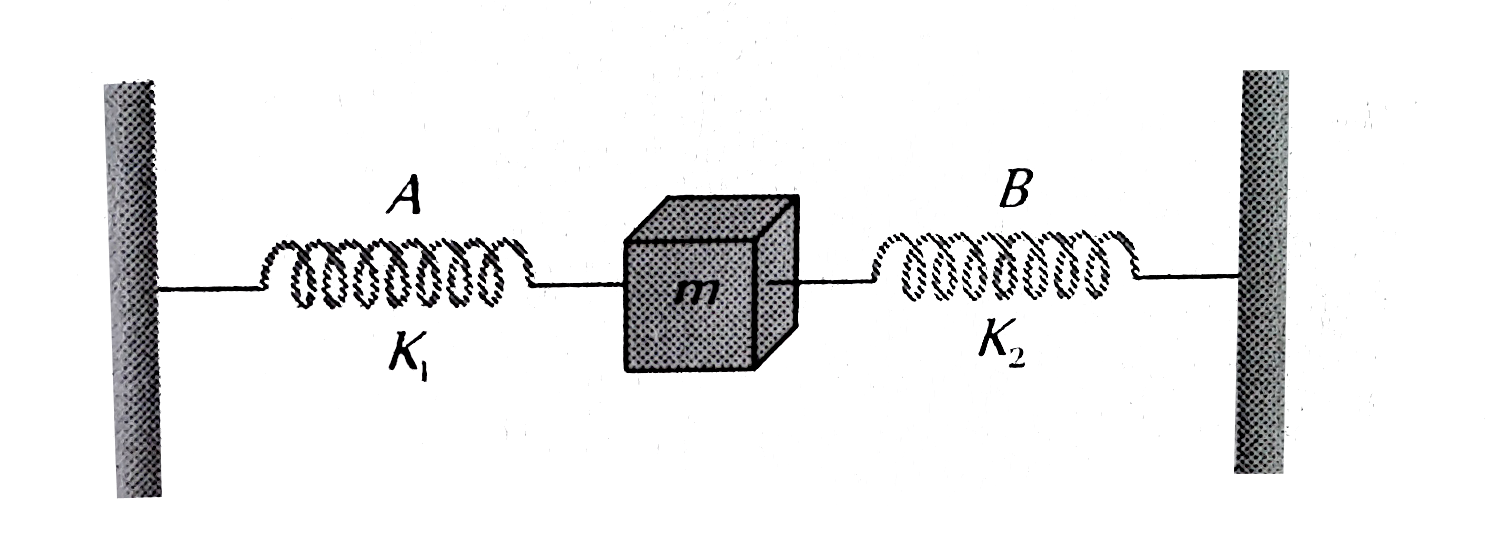 02:22View Solution
02:22View SolutionTwo identical spring of constant K are connected in series and parallel as shown in figure. A mass mis suspended from them. The ratio of their frequencies of vertical oscillations will be
 03:32View Solution
03:32View SolutionA mass m is suspended from the two coupled springs connected in series. The force constant for springs are `k_(1) "and" k_(2).` The time period of the suspended mass will be
01:37View SolutionA spring is stretched by 0.20 m , when a mass of 0.50 kg is suspended. When a mass of 0.25 kg is suspended, then its period of oscillation will be `(g = 10 m//s^(2))`
02:45View SolutionA mass `M` is suspended from a spring of negiliglible mass the spring is pulled a little and then released so that the mass executes simple harmonic oscillation with a time period `T` If the mass is increases by `m` the time period because `((5)/(4)T)`,The ratio of `(m)/(M)` is
02:11View SolutionA spring having a spring constant k is loaded with a mass m. The spring is cut into two equal parts and one of these is loaded again with the same mass. The new spring constant i
01:44View SolutionA massless spring, having force constant k, oscillates with frequency n when a mass m is suspended from it. The spring is cut into two equal halves and a mass `2m` is suspended from one half. The frequency of oscillation will now be
03:03View Solution`A` mass `M` is suspended from a light spring. An additional mass `m` added to it displaces the spring further by distance `x` then its time period is
03:15View SolutionIn figure `S_(1)` and`S_(1)` are identical springs. The oscillation frequency of the mass `m` is `f`. if one spring is removed, the frequency will become
 02:24View Solution
02:24View SolutionThe vertical extension in a light spring by a weight of 1 kg suspended from the wire is 9.8 cm . The period of oscillation
01:11View SolutionA particle of mass 200 g executes a simpel harmonit motion. The resrtoring force is provided by a spring of spring constant `80 N m^-1`. Find the time period.
02:02View SolutionThe length of a spring is l and its force constant is k . When a weight W is suspended from it, its length increases by x . If the spring is cut into two equal parts and put in parallel and the same weight W is suspended from them, then the extension will be
02:00View SolutionA block is placed on a frictionless horizontal table. The mass of the block is m and springs are attached on either side with force constants ` K_(1) and K_(2)` . If the block is displaced a little and left to oscillate, then the angular frequency of oscillation will be
02:21View SolutionA spring of certain length and having spring constant `k` is cut into two pieces of length in a ratio `1:2`. The spring constants of the two pieces are in a ratio `:`
01:39View SolutionA mass m = 100 gm is attached at the end of a light spring which oscillates on a frictionless horizontal table with an amplitude equal to 0.16 metre and time period equal to 2 sec. Initially the mass is released from rest at t = 0 and displacement x = –0.16 metre. The expression for the displacement of mass at any time t is
02:47View SolutionA block of mass m, attached to a spring of spring constant k, oscilltes on a smooth horizontal table. The other end of the spring is fixed to a wall. If it has speed v when the spring is at its naturla lenth, how far will it move on the table before coming to an instantaneous rest?
03:27View SolutionThe force constants of two springs are`K_(1) and K_(2)`. Both are stretched till their elastic energies are equal. If the stretching forces are ` F_(1) and F_(2) then F_(1) : F_(2)` is
01:30View SolutionA mass m is vertically suspended from a spring of negligible mass, the system oscillates with a frequency n. what will be the frequency of the system, if a mass `4m` is suspended from the same spring?
00:59View SolutionIf the period of oscillation of mass M suspended from a spring is one second, then the period of 4M will be
01:50View SolutionFive identical springs are used in the following three configurations. The time periods of vertical oscillations in configurations (i), (ii) and (iii) are in the ratio
 02:04View Solution
02:04View SolutionA mass m performs oscillations of period T when hanged by spring of force constant K . If spring is cut in two parts and arranged in parallel and same mass is oscillated by them, then the new time period will be
 01:42View Solution
01:42View SolutionIf a watch with a wound spring is taken on to the moon, it
01:11View SolutionWhat will be the force constant of the spring system shown in figure?
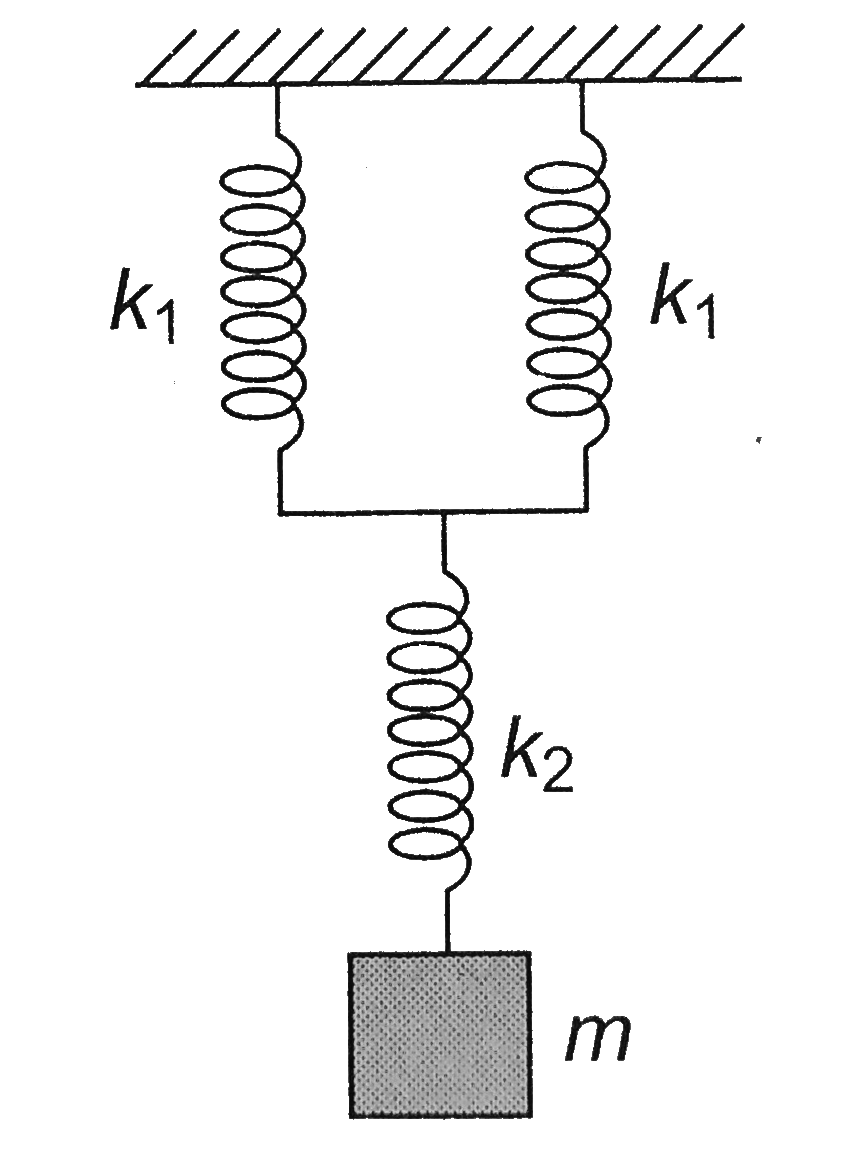 01:12View Solution
01:12View SolutionTwo springs have their force constants `K_(1)` and `K_(2)` and they are stretched to the same extension. If `K_(2) gt K_(1)` work done is
01:49View SolutionThe effective spring constant of two spring system as shown in figure will be
 02:11View Solution
02:11View SolutionA mass (M) attached to a spring, oscillates with a period of (2 sec). If the mass in increased by (2 kg) the period increases by one sec. Find the initial mass (M) assuming that Hook's Law is obeyed.
01:51View SolutionA mass M is suspended by two springs of force constants `K_(1) and K_(2)` respectively as shown in the diagram. The total elongation (stretch) of the two springs is
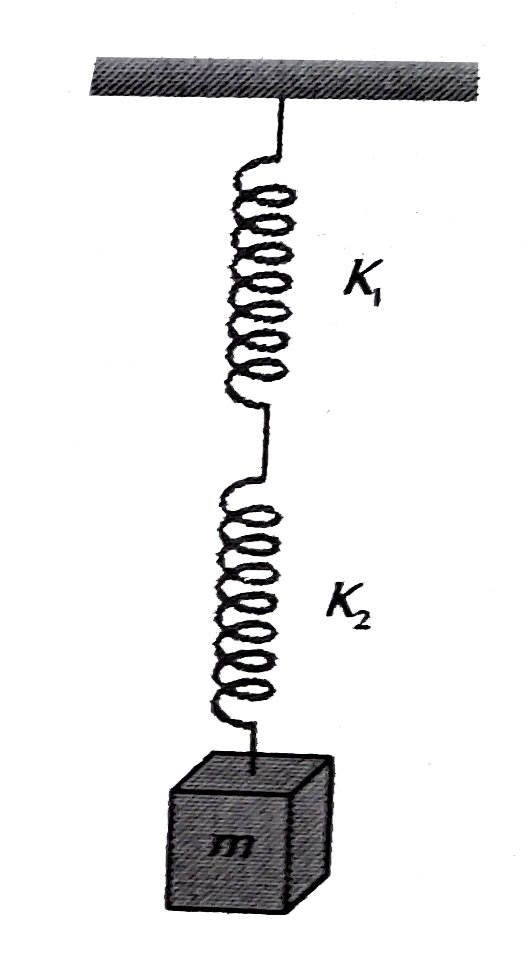 01:30View Solution
01:30View SolutionThe frequency of oscillation of the springs shown in the figure will be
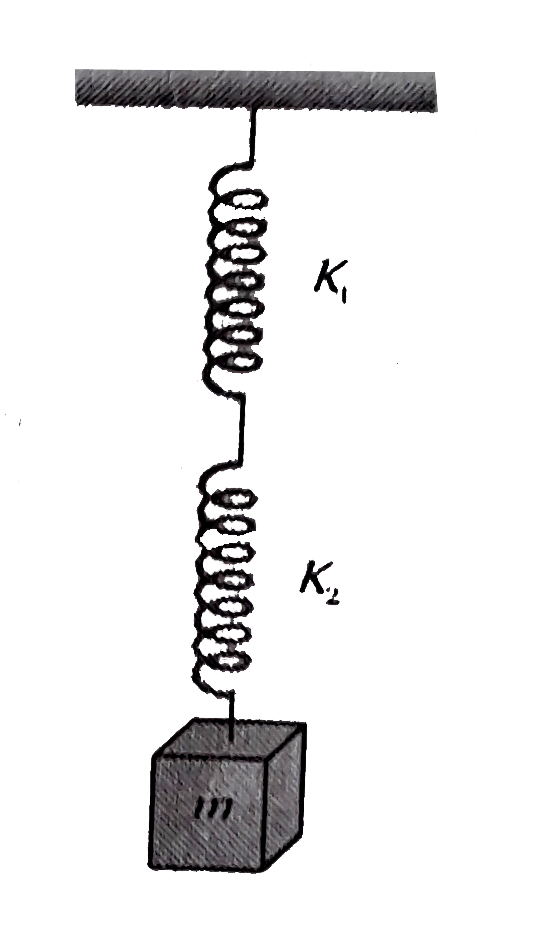 01:18View Solution
01:18View SolutionThe scale of a spring balance reading from 0 to 10 kg is 0.25 m long. A body suspended from the balance oscillates vertically with a period of `pi//10` second. The mass suspended is (neglect the mass of the spring)
02:07View SolutionIf a spring has time period T, and is cut into (n) equal parts, then the time period of each part will be.
01:10View SolutionOne-forth length of a spring of force constant K is cut away. The force constant of the remaining spring will be
01:10View SolutionA mass `m` is suspended separately by two different spring of spring constant `K_(1)` and `k_(2)` given the time period `t_(1)` and`t_(2)` respectively if the same mass `m` is shown in the figure then time period `t` is given by the relation
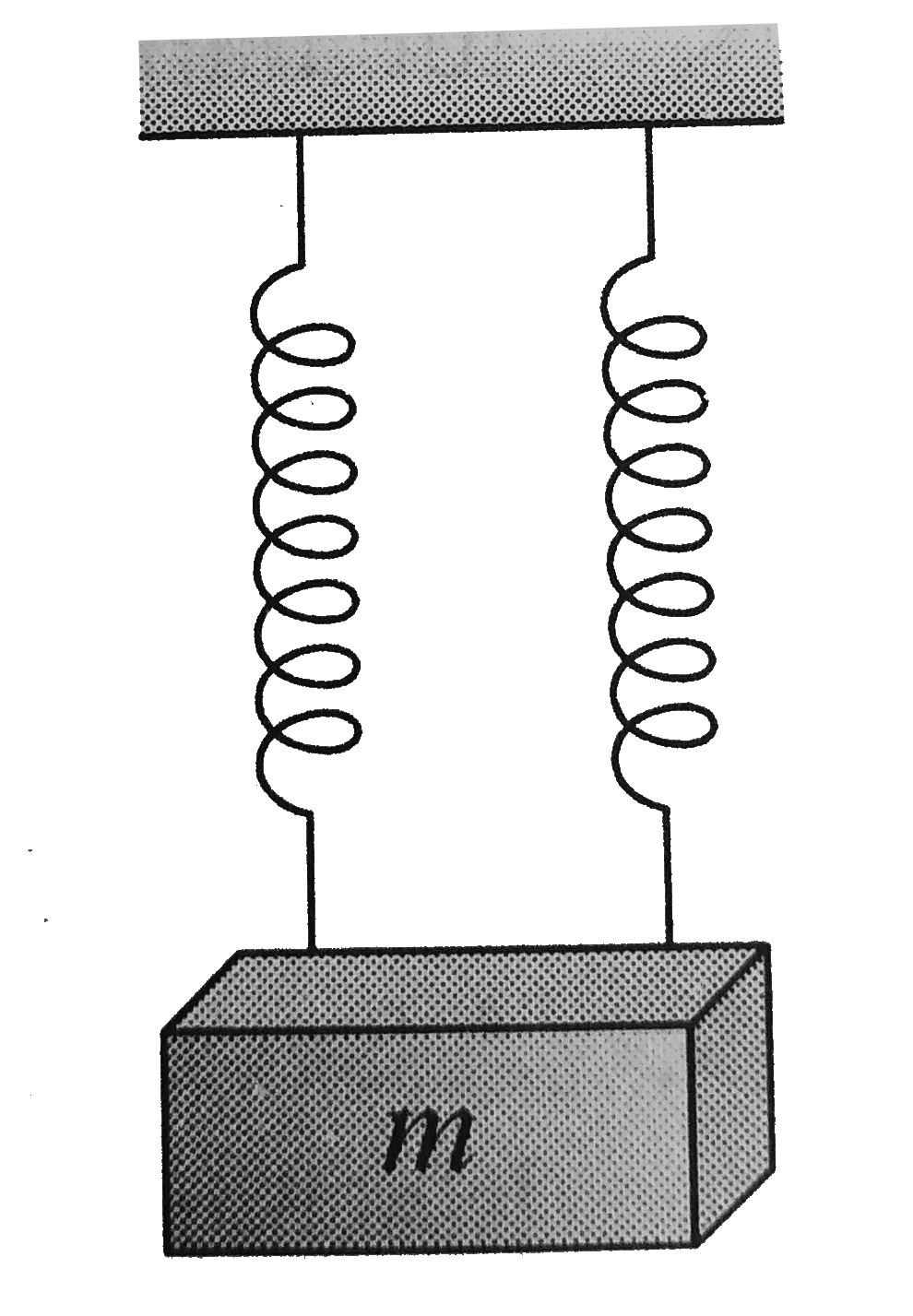 03:40View Solution
03:40View SolutionTwo spring of force constants `K` and `2K` are connected a mass `m` below The frequency of oscillation the mass is
 01:46View Solution
01:46View SolutionTwo springs of spring constants`K_(1)` and `K_(2)` are joined in series. The effective spring constant of the combination is given by
00:54View SolutionA particle at the end of a spring executes simple harmonic motion with a period `t_(1)` while the corresponding period for another spring is `t_(2)` if the oscillation with the two springs in series is T then
05:37View SolutionInfinite springs with force constant`k , 2k, 4k and 8 k .... respectively are connected in series. The effective force constant of the spring will b
03:43View SolutionTo make the frequency double of a spring oscillator, we have to
01:46View SolutionThe springs shown are identical. When A =4 kg , the elongation of spring is 1 cm . If B = 6kg , the elongation produced by it is
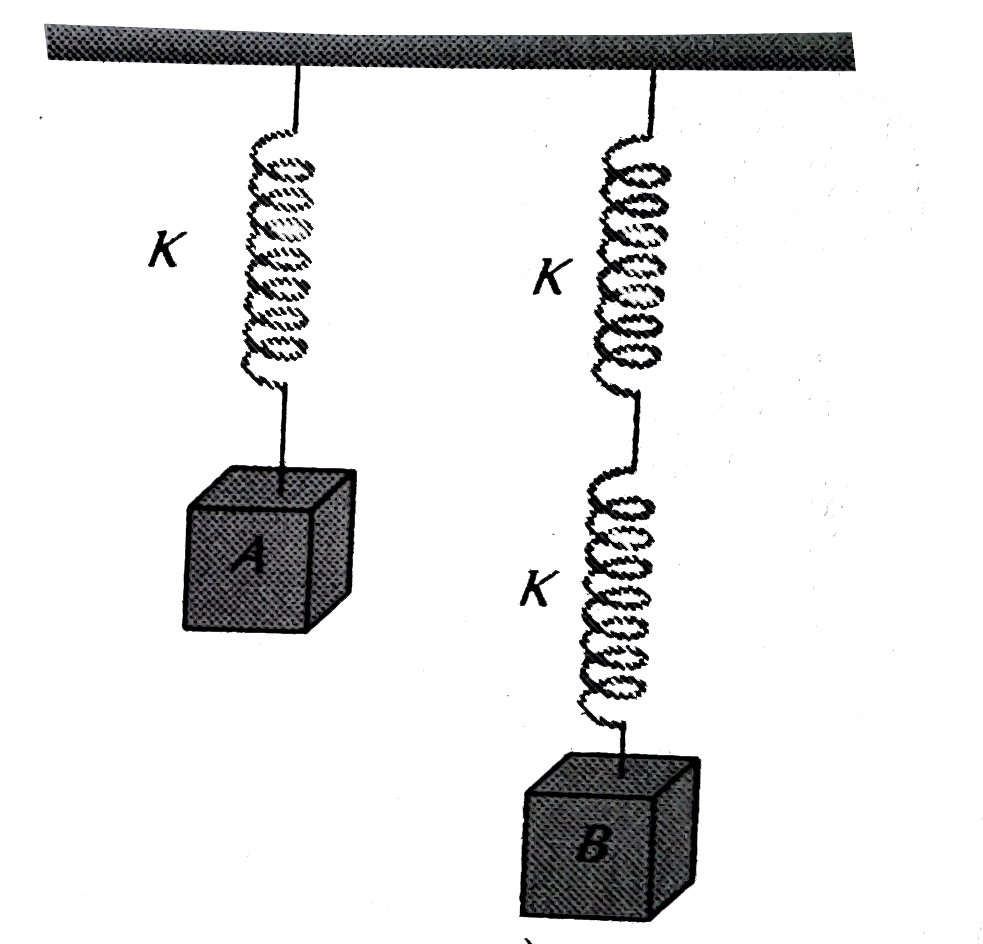 02:35View Solution
02:35View SolutionWhen a body of mass `1.0 kg` is suspended from a certain light spring hanging vertically, its length increases by `5cm`. By suspending `2.0kg` block to the spring and if the block is pulled through `10cm` and released, the maximum velocity of it in `m//s is (g = 10 m//s^(2))`
02:14View SolutionTwo springs with spring constants m ` K _(1) = 1500 N//m`and m `K_(2) = 3000 N//m` are stretched by the same force. The ratio of potential energy stored in spring will be
01:52View SolutionIf a spring extends by `x` on loading, then then energy stored by the spring is (if T is tension in the spring and k is spring constant)
01:19View SolutionA weightless spring of length 60 cm and force constant 200 N/m is kept straight and unstretched on a smooth horizontal table and its ends are rigidly fixed. A mass of 0.25 kg is attached at the middle of the spring and is slightly displaced along the length. The time period of the oscillation of the mass is
01:51View SolutionThe time period of a mass suspended from a spring is T. If the spring is cut into four equal parts and the same mass is suspended from one of the parts, then the new time period will be
02:19View SolutionA mass (M) is suspended from a spring of negligible mass. The spring is pulled a little and then released so that the mass executes SHM of time period T. If the mass is increased by m, the time period becomes `(5T)/3`. Then the ratio of `m/M` is .
01:52View SolutionAn object is attched to the bottom of a light vertical spring and set vibrating. The maximum speed of the object is `15cm//s` and the period is `628` milli seconds. The amplitude of the motion in centimetres is
02:17View SolutionWhen a mass m is attached to a spring, it normally extends by 0.2 m . The mass m is given a slight addition extension and released, then its time period will be
01:42View SolutionIf a body of mass 0.98 kg is made to oscillate on a spring of force constant 4.84 N/m the angular frequency of the body is
01:37View SolutionA mass m is suspended from a spring of length l and force constant K . The frequency of vibration of the mass is `f_(1)`. The spring is cut into two equal parts and the same mass is suspended from one of the parts. The new frequency of vibration of mass is `f_(2)` . Which of the following relations between the frequencies is correct
02:43View SolutionA mass m oscillates with simple harmonic motion with frequency `f= omega/(2pi)`and amlitude A on a spring with constant K. therefore
02:36View SolutionTwo masses m 1 and m 2 are suspended together by a massless spring of constant K . When the masses are in equilibrium, m 1 is removed without disturbing the system. The amplitude of oscillations is
 04:19View Solution
04:19View SolutionA spring executes SHM with mass of 10 kg attached to it. The force constant of spring is 10 N/m. If at any instant its velocity is 40 cm/sec, the displacement will be (where amplitude is 0.5 m )
02:38View Solution
spring pendulum questions and complete solutions for chapter SIMPLE HARMONIC MOTION of UNIVERSAL BOOK DEPOT 1960 PHYSICS (HINGLISH) of Class 11
